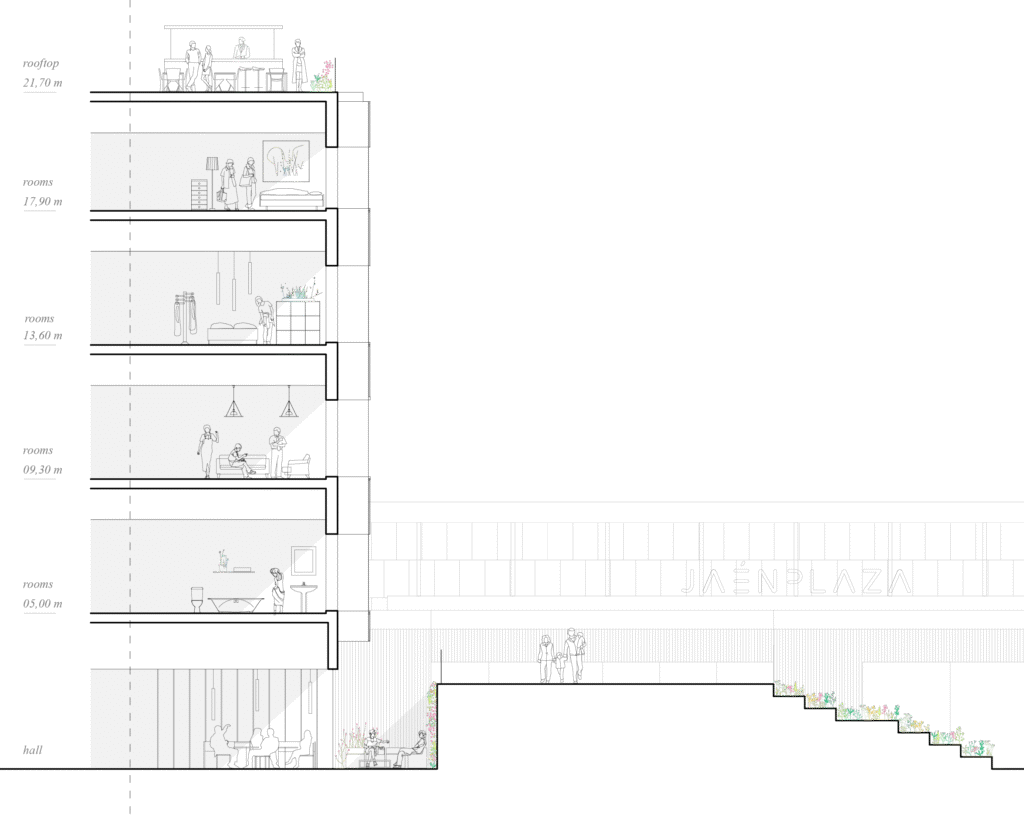Traveling can be an emotional event
The Journey Hotel
Client
Location
Category
Visuals
Furniture
Sancal, Santa&Cole & Masiero
The Journey Hotel:
Project report
Travel can be an emotional experience, and hotel design offers a unique opportunity to enhance that journey.
In the frantic pace of today’s world, everything seems to advance rapidly, yet rest gradually returns to its original purpose. Traveling connects us deeply to the discovery of a place, fostering a feeling of connection not only with the destination but also with ourselves.
Discovering a new place means immersing yourself in its culture and getting to know its people and their environment. Traveling could be seen as a brief stop along the way, but in reality, it’s possible to experience local life if you’re willing to seek the place’s true essence—slowing down the pace and easing the anxiety that often accompanies exploration.
– Jaén, Spain.

The section reveals how The Journey dissolves traditional boundaries between interior and exterior, emphasizing a seamless connection with its surroundings. Rather than a static form, the building responds dynamically to its context, allowing natural elements like greenery to infiltrate and soften the interior spaces.
The ground floor, while subtly tucked behind the large welcoming plaza, remains intrinsically linked to the adjacent shopping center. This fluid relationship is enhanced through carefully modulated materiality and spatial layering, where thresholds adapt according to privacy needs and degrees of openness.
Here, permeability becomes a key design strategy, creating a dialogue between the building, its users, and the surrounding urban fabric, inviting visitors to slow down and immerse themselves fully in the experience.
The plan of The Journey is conceived as a flexible and porous system, where multiple environments coexist within open spatial frameworks. Common areas prioritize permeability, encouraging interaction and fluid movement between users and spaces. Landscape plays a vital role, extending the green areas from the exterior deep into the building’s heart, blurring the line between inside and outside.
By prioritizing adaptability in spatial organization, The Journey becomes more than a hotel — it transforms into a living, breathing ecosystem where every corner invites discovery and community.
The Journey for a modern traveler
Beyond the traditional hotel
Listening to the local community allows us to learn and pursue a real experience, immersing ourselves in their customs where the hotel should be part of that adventure. Travel, a very everyday action and integrated in our day to day, we travel for work, we travel for leisure, we travel for our family, we travel to know new places… Here we conceive travel as a process of learning and experience.
A philosophy that is explored in the development of this hotel project. This is how The Journey emerges, a hotel that explores the connection between the permeability of active spaces and the use they house, with the aim of providing flexibility and catering for the needs of users who live there.
A fundamental pillar is the immediacy and direct relationship that the hotel keeps with its environment, this being the shopping center Jaén Plaza, thus affecting the concept of traditional hotel that we know.
This generates that instead of focusing solely on offering a place to sleep, The Journey presents spaces that not only serve for himself but for what surrounds him, is why it is characterized by permeability and porosity in its common spaces. In this respect the building is understood as flexible not so much in its formality as in its spatial organization in which within the same space are generated multiple environments that are efficiently adapted to the needs of customers.
It is in this dissolution of the limits and the relation of the served-server spaces that lies the true value of The Journey. The ground floor, although at first sight hidden behind the large square that introduces and presents itself to the shopping center, does not stop wanting to link to it, being conquered by the green areas that even dominate its interior space as if it were an extension; also the materiality of the limits that according to the degree of privacy and connection they have with the outside are defined to a greater or lesser extent.
A fundamental pillar is the immediacy and direct relationship that the hotel keeps with its environment, this being the shopping center Jaén Plaza, thus affecting the concept of traditional hotel that we know.
This generates that instead of focusing solely on offering a place to sleep, The Journey presents spaces that not only serve for himself but for what surrounds him, is why it is characterized by permeability and porosity in its common spaces.
In this respect the building is understood as flexible not so much in its formality as in its spatial organization in which within the same space are generated multiple environments that are efficiently adapted to the needs of customers.
El viaje es una experiencia que redefine el espacio,
el lugar y el ser
The journey is an experience that redefines space, place, and being
